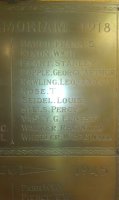Hamlet historian Roger Deason drew up a Dulwich Hamlet FC Roll of Honour in 2005 based on the Dulwich Hamlet FC Handbook for 1919. More details of the individuals named can be found at the Hamlet Historian
http://thehamlethistorian.blogspot.co.uk/2011_08_01_archive.html
DULWICH HAMLET FOOTBALL CLUB
ROLL OF HONOUR 1914-1919
THE GREAT WAR
Walter Lester Lawrence
Date of Death : 2 December 1914 aged 22.
Rank & Unit : Private, A Squadron Royal Bucks Hussars.
Buried : Norwood Cemetery.
George Ernest Vasey (Ernie)
Date of Death : 27 April 1915. (The officially recorded date, contemporary news-
papers report 26th.)
Rank & Unit : Lance Corporal, 1st/5th Battalion London Regiment. London Rifle Brigade.
Buried : No known grave. Recorded on the Menin Gate Memorial.
Stanley Brace Peart
Date of Death : 25 May 1915.
Rank & Unit : Rifleman, 1st/21st Battalion, London Regiment. 1st Surrey Rifles.
Buried : No known grave. Recorded at the Le Touret Memorial.
Reginald Astill (Reg.)
Date of Death : 1 July 1916.
Rank & Unit : Rifleman. 1st/9th Battalion, London Regiment. Queen Victoria Rifles.
Buried : No known grave. Recorded on Thiepval Memorial at The Somme.
George Arthur Popple
Date of Death : 1 July 1916.
Rank & Unit : Sergeant. 1st/12th Battalion London Regiment The Rangers.
Buried : No known grave. Recorded on Thiepval Memorial, The Somme.
Tommy Rose
Date of Death : 2 August 1916 aged 35.
Rank & Unit : Bombardier. 156th Brigade, Royal Field Artillery.
Buried : St Sever Cemetery, Rouen.
Louis F. Seidel
Date of Death : 14 August 1916.
Rank & Unit : Commander, Uganda
Volunteer Reserve. (Railway)
Buried : Voi Cemetery, Kenya.
Francis W. Hagger (Frank)
Date of Death : 1 October 1916.
Rank & Unit : Rifleman 1st/16th Battalion
London Regiment
Queen’s Westminster Rifles.
Buried : No known grave. Remembered on the Thiepval Memorial.
Reginald Walker*
Date of Death : 23 December 1916.
Rank & Unit : Private 11th Battalion The Queen’s Royal West Surrey Regiment.
Buried : Hazebrouck Communal Cemetery.
William George Dunbar Clarkson (Willie)
Date of Death : 31 March 1917.
Rank & Unit : Private, 7th Battalion Royal Sussex Regiment.
Buried : No known grave. Honoured on the Arras Memorial.
Walter Reginald Wheeler (Reginald)
Date of Death : 31 March 1917 aged 27.
Rank & Unit : Rifleman 2nd/21st Battalion London Regiment.
1st Surrey Rifles.
Buried : Salonika Military Cemetery.
Leonard John Rawling
Date of Death : 12 April 1917 aged 29.
Rank & Unit : Private. 7th Battalion Royal Sussex Regiment.
Buried : No known grave. Honoured on the Arras Memorial.
William Henry Nixon
Date of Death : 24 April 1917 aged 26.
Rank & Unit : 2nd Lieutenant 298 Siege Battery, Special Reserve, Royal Garrison Artillery.
Buried : Vlamertinghe Military Cemetery near Ypres.
Frank Sydney Marsh
Date of Death : 28 April 1917 aged 23.
Rank & Unit : 2nd Lieutenant 1st R.M Bat, R.N.
Royal Marine Light Infantry.
Buried : No known grave. Honoured on the Arras Memorial.
Edward L. Bescoby* (Eddie)
Date of Death : 18 June 1917 aged 25.
Rank & Unit : Second Lieutenant, Royal Fusiliers.
Buried : Ljssenthoek Military Cemetery.
Gilbert Furmage Chignall
Date of Death : 7 June 1917.
Rank & Unit : Lance Corporal 1st/23rd County of London Battalion London Regiment.
Buried : No known grave. Honoured on the Menin Gate Memorial.
Ernest William Dearne Astill
Date of Death : 30 March 1918.
Rank & Unit : Second Lieutenant 2nd/9th Battalion London Regiment
(Queen Victoria Rifles).
Buried : No known grave. Remembered on the Pozieres Memorial,
The Somme.
Jack Harold Chance Butler
Date of Death : 6 August 1918 aged 27.
Rank & Unit: Sergeant, 237 Siege Battery, Royal Garrison Artillery.
Buried : Terlincthun Cemetery.
Sidney Herbert Beales
Date of Death : 25 August 1918 aged 34.
Rank & Unit: Private, 1st/13th Princess Louise’s Battalion, London Regiment.
Buried : No known grave. Remembered at Vis en Artois Memorial.
Albert Charles Andrews
Rank & Unit: Serjeant AJ Andrews (530016), London Regiment
(Prince of Wales Own Civil Service Rifles), date of death, 21/05/1916, aged 26
Buried: Souchez Canadian Cemetery, four miles from Lens.
Robert Charles Lawrence D.C.M.
Date of Death : 19 October 1918 aged 29.
Rank & Unit : Sergeant, 231st Brigade Royal Field Artillery.
Buried : Vadencourt British Cemetery, Maissemy.
Percy Sills
Date of Death : 6 November 1918.
Rank & Unit : Acting Lance Corporal, Labour Corp.
Buried : Scartho Road Cemetery, Grimsby.
















